22 August 2018
Q&A, episode 5
Posted by Callan Bentley
After a bit of a respite, it’s now time for a fresh edition of “you ask the questions” here on Mountain Beltway. Anyone can ask a question, serious or spurious, and I’ll do my best to answer it here. Use the handy Google Form to to submit your questions anonymously.
Here’s this week’s question:
7. What is foliation and what makes it so important to the structure of rock?
Foliation is a planar alignment of mineral grains in a rock. It’s dependent on those mineral grains not being spherical, but having some non-equant shape, like a flake or a line. If you get all those flakes (or all those lines) in a common orientation, it imparts a “fabric” to the rock, in the same way that the alignment of plant cells in a log give it a “grain.” Just as it’s easier to split a log along the grain than across it, it’s often easier to split a rock along the foliation than across it. In this case (easier to split in one direction), we’d say the rock has not just a foliation, but a cleavage. So a cleavage is a foliation that is also a plane of weakness.
Foliation can have several causes: it could be a primary feature, say due to flow in a molten rock mass, but more commonly it refers to a tectonic feature, imposed on a pre-existing rock by differential stress (stress that’s greater in one direction than in other directions). As such, foliation is a secondary structure, and example of strain, a deformational feature that develops in rocks that have been squeezed by geological processes. Because rocks in these settings are often recrystallized under high temperatures and pressures, rocks that are foliated are often also metamorphic rocks. But you can have the one without the other.
A common way to get foliation to develop is through pressure solution. Pressure solution is a phenomenon where certain minerals dissolve under high pressure, and re-precipitate under lower pressures. Calcite is particularly susceptible to this, but quartz does it too.
Here’s an example of evidence for this phenomenon: “bearded” porphyroclasts in metamorphosed turbidites exposed on the north shore of the Isle of Arran, Scotland, just west of Lochranza:

Now an annotated version , to show the shape of the stiff, strong grain (porphyroclast) that resists dissolution, and the “beard” or “fringe” of precipitated quartz that grows in the “pressure shadow” adjacent to the grain:

All that quartz in the fringe adjacent to the porphyroclast had to come from somewhere. And where it came from is likely the direction 90° to the long axis of the fringe. It dissolves in the highest-stress direction (up and down in these photos) and re-precipitates in the least-stress direction (left and right in these photos). Here’s another example, also from Lochranza:

This one shows an additional feature, a dilational crack that has partially split the porphyroclast and opened up a little vein (also in the low-pressure zone). I’ve highlighted it with a blue arrow:
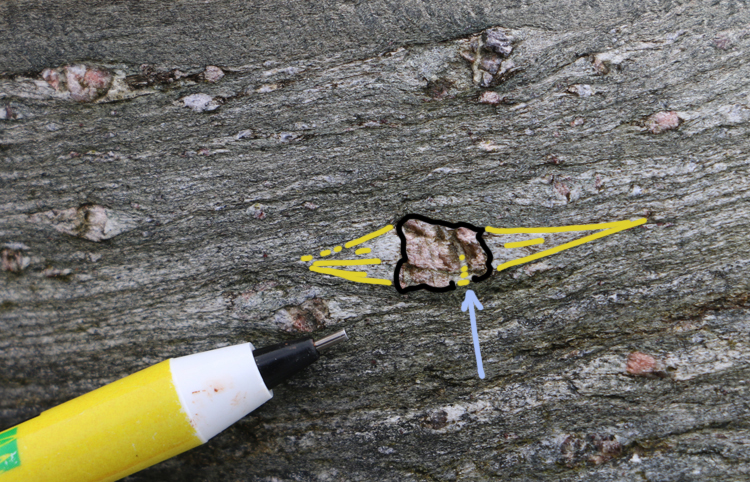
A rock body full of grains like these, shortened in one direction and enhanced in another, attains a fabric. It gets foliated. These Scottish rocks I’ve shown so far are interesting because the bedding (defined by grain size) and the foliation (defined by alignment of the mineral grains) are parallel:

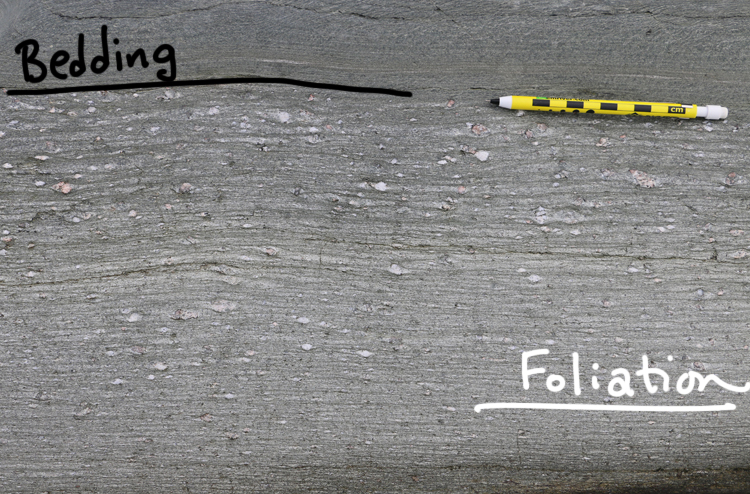
That implies the maximum stress direction was perpendicular to bedding, which is to say, vertical (all else being equal).
In many circumstances, this is not the case. Next, take a look at an outcrop showing ~horizontal bedding and ~vertical foliation (Chancellor Group limy slates in Yoho National Park, British Columbia). Here, they are perpendicular to one another:

All else being equal, this might be the default expectation for metasedimentary rocks: the bedding is initially horizontal, and so is the tectonic shortening direction (thanks to plate tectonics), so we would expect a more or less vertical foliation.
Here is an outcrop showing bedding and foliation in metasedimentary rocks (Frog Lakes Conglomerate in the high Sierras of California), showing a non-parallel, non-perpendicular relationship:
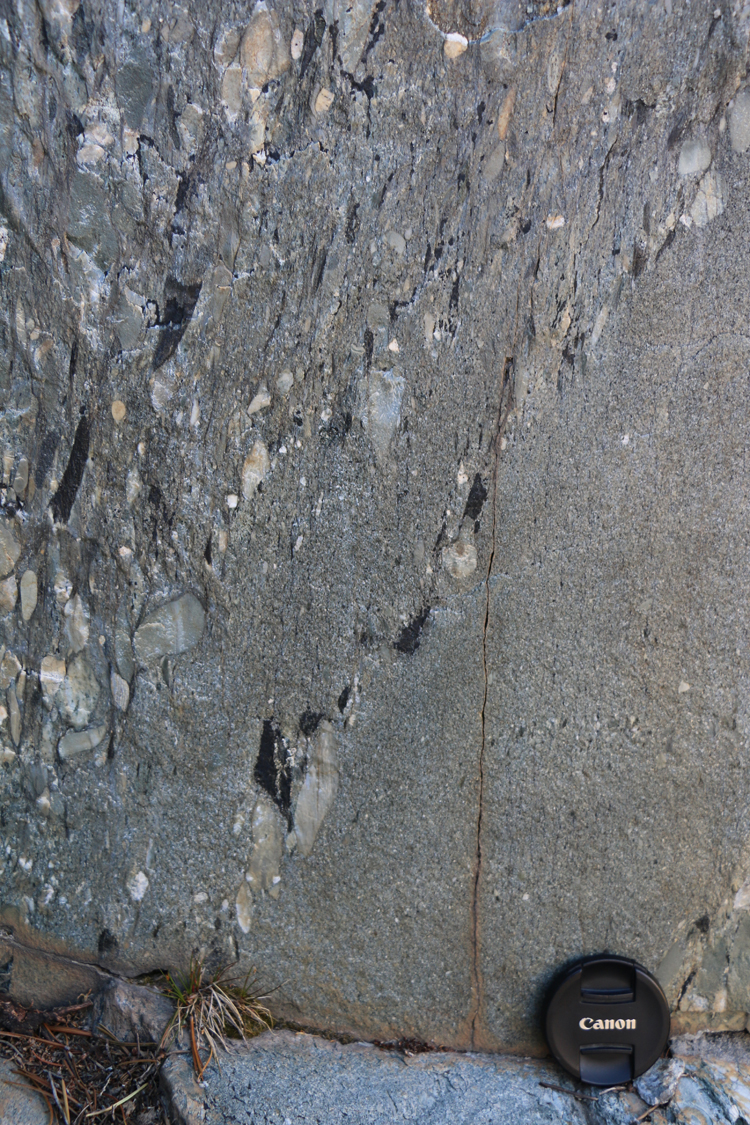
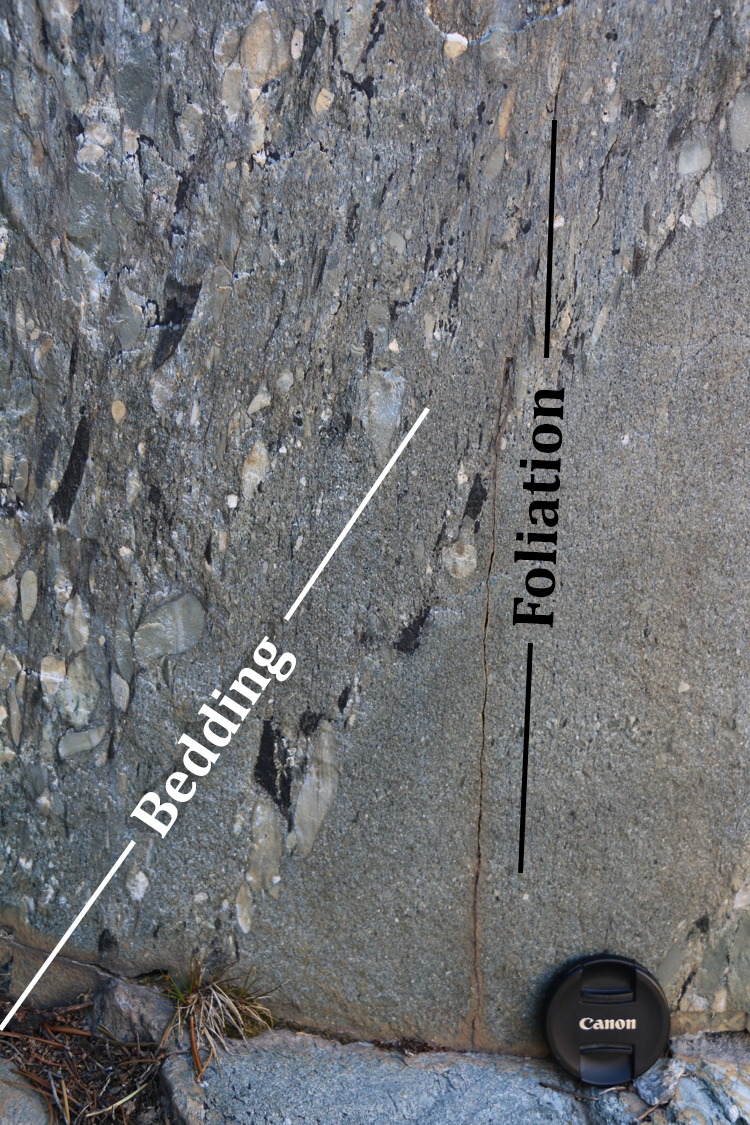
Here is bedding and cleavage expressed in limestone and shale/slate of the Edinburg Formation, near Lexington, Virginia:

There’s clearly a lithological control on foliation’s development, right? It’s only weakly developed in the pure limestone, but where there’s a bit of clay in the rock layers, foliation/cleavage is pronounced and obvious. [Link to a GigaPan showing a similar outcrop]
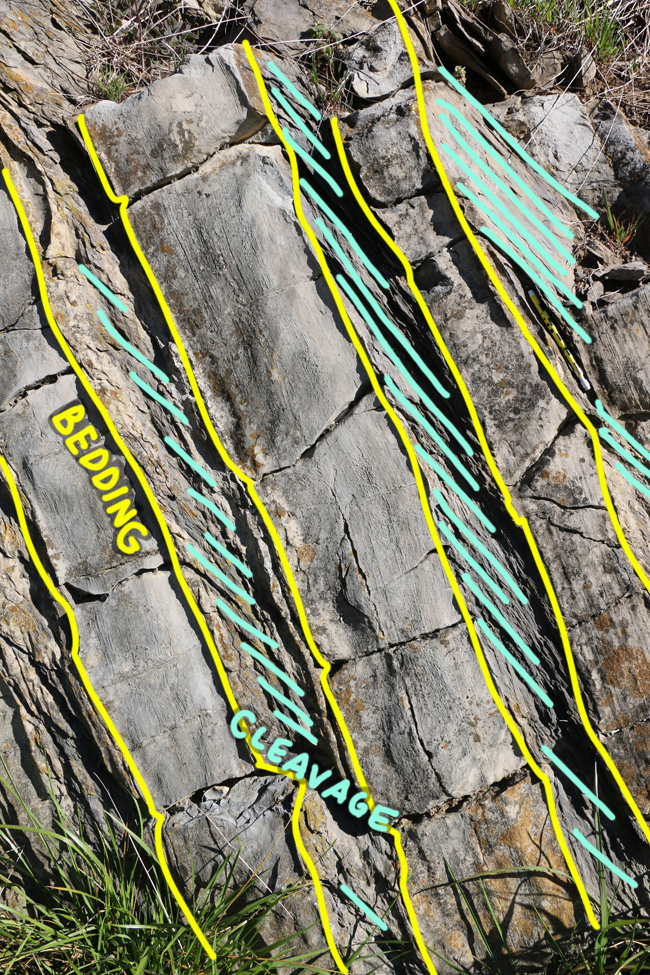
Again there is an angular relationship between the two planar features. But this one illustrates nicely how bedding and cleavage both dip to the right, however bedding is steeper (closer to vertical) and cleavage is shallower (more moderately dipping), the opposite of the California example. This tells us that these beds have been tectonically inverted (flipped over).
Where seams of pressure solution are localized with big gaps between them, we dub them stylolites, and to believe the testimony of marker units such as calcite veins, they are apparently capable of dissolving away huge volumes of squeezed rock:


Where the pressure dissolution is more evenly distributed through the body of rock, and in particular where it changes the average grain shape within the rock or aligns non-soluble platy minerals (such as clays or micas), you get a proper foliation (± cleavage), like this example from the Swift Run Formation in the Virginia Blue Ridge:

And here is an example from a slab of building stone in Baltimore, Maryland:

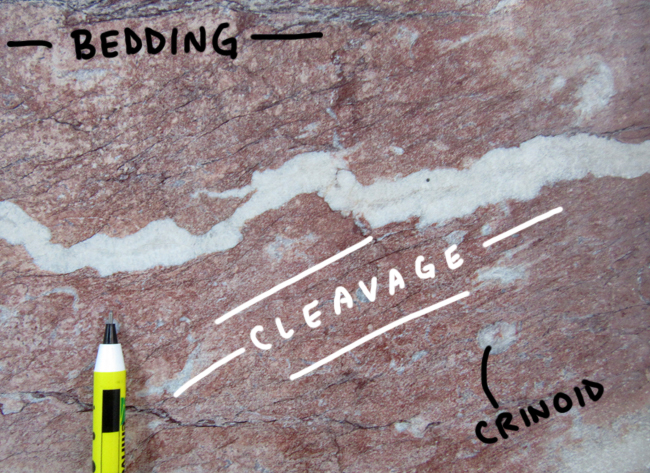
Now for some interactive media: embedded GigaPans and GIGAmacros and also 3D models. We’ll start with the Chancellor Slate (shown earlier in this post), because it’s such a beautiful example of bedding and cleavage relationships:
Here’s an example of mylonite, a highly foliated rock formed along hot fault zones:
Here’s an example of cleavage refracting across sedimentary layers with varying amounts of clay vs. silt (Neoproterozoic Konnarock Formation of Virginia):
Here is an example of gneiss (Archean basement of Montana), which shows a much coarser flavor of foliation: it’s a 3D model, so you can spin it around and examine how the foliation looks from different angles.
Here is another 3D model, an example of an “L-S tectonite” (phyllitic metavolcanics from the Phoenix Mountains of Arizona), which shows a well-developed lineation on the plane of the foliation:
As for the second part of the question, about why foliation is important, I’d say that the single biggest reason is that it is one of the principal signatures of tectonic shortening (in one direction); implying tectonic elongation in another direction. Mountain belts form when rocks are shortened horizontally and thickened vertically. Though mountains are ephemeral features on the face of our planet (because erosion reduces their topographic expression over geologic time), the rocks at their roots will show foliation, and that tells us about the ancient episodes of tectonic squeezing they have enjoyed.
If you have other questions about science, the Earth system, or anything else, please ask them.


 Callan Bentley is Associate Professor of Geology at Piedmont Virginia Community College in Charlottesville, Virginia. He is a Fellow of the Geological Society of America. For his work on this blog, the National Association of Geoscience Teachers recognized him with the James Shea Award. He has also won the Outstanding Faculty Award from the State Council on Higher Education in Virginia, and the Biggs Award for Excellence in Geoscience Teaching from the Geoscience Education Division of the Geological Society of America. In previous years, Callan served as a contributing editor at EARTH magazine, President of the Geological Society of Washington and President the Geo2YC division of NAGT.
Callan Bentley is Associate Professor of Geology at Piedmont Virginia Community College in Charlottesville, Virginia. He is a Fellow of the Geological Society of America. For his work on this blog, the National Association of Geoscience Teachers recognized him with the James Shea Award. He has also won the Outstanding Faculty Award from the State Council on Higher Education in Virginia, and the Biggs Award for Excellence in Geoscience Teaching from the Geoscience Education Division of the Geological Society of America. In previous years, Callan served as a contributing editor at EARTH magazine, President of the Geological Society of Washington and President the Geo2YC division of NAGT.
Excellent throughout, many thanks!
Keep in mind foliation in rock masses impact there strength/shear strength under stress. This has ramifications for foundation design, tunnelling, and mining. Also foliation/cleavage in rock can impact the flow of groundwater through fractures in the rock leading to preferential flow directions. This can be important to understand when dealing with the movement of contamination in a fractured bedrock aquifer.
Absolutely!
Thanks for chiming in.
Excellent presentation. I need to get similar 3D models in hand for my own teaching purposes. Nice!